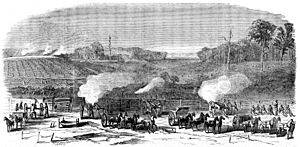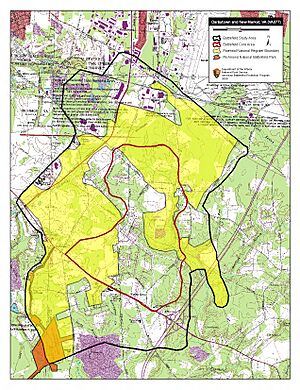Battle of Darbytown and New Market Roads facts for kids
Quick facts for kids Battle of Darbytown and New Market Roads |
|||||||
|---|---|---|---|---|---|---|---|
| Part of the American Civil War | |||||||
 |
|||||||
|
|||||||
| Belligerents | |||||||
| Commanders and leaders | |||||||
| Ulysses S. Grant David B. Birney August V. Kautz |
Robert E. Lee | ||||||
| Strength | |||||||
| X Corps | 2 Divisions | ||||||
| Casualties and losses | |||||||
| 458 (Killed 49, Wounded 253, Captured or Missing 156) |
700 | ||||||
The Battle of Darbytown and New Market Roads was an important fight during the American Civil War. It happened on October 7, 1864, in Henrico County, Virginia. This battle was part of a bigger plan called the Richmond-Petersburg Campaign. In this battle, soldiers from the Union fought against soldiers from the Confederacy. The Union forces won this battle.
Why This Battle Happened
The Richmond-Petersburg Campaign was a long effort by the Union Army. Their goal was to capture the city of Petersburg, Virginia. This city was defended by Confederate forces led by General Robert E. Lee.
During an earlier fight, the Battle of Chaffin's Farm, Union soldiers captured a place called Fort Harrison. This happened on September 30, 1864. After losing the fort, General Lee decided to attack the Union forces. He wanted to push them back. This attack led to the Battle of Darbytown and New Market Roads.
The Battle Begins
The Union Army had strong defensive lines. These lines were along New Market Road. Union cavalry (soldiers on horseback) also protected Darbytown Road. These Union forces were commanded by Brig. Gen. August V. Kautz and Maj. Gen. David B. Birney.
The Confederate attack started with Maj. Gens. Robert Hoke and Charles W. Field leading their troops. They successfully pushed back the Union cavalry from Darbytown Road. The cavalry had to retreat from the area.
The Fight Continues
After pushing back the cavalry, the Confederates then attacked the main Union lines. These lines were on New Market Road. During this intense fighting, a Confederate leader named Brig. Gen. John Gregg was killed. He was the commander of the Texas Brigade.
Despite their efforts, the Confederate attack was stopped. The Union soldiers held their ground. Because their attack failed, the Confederates had to retreat. They pulled back towards Richmond. This retreat meant that the Union Army had won the battle.


